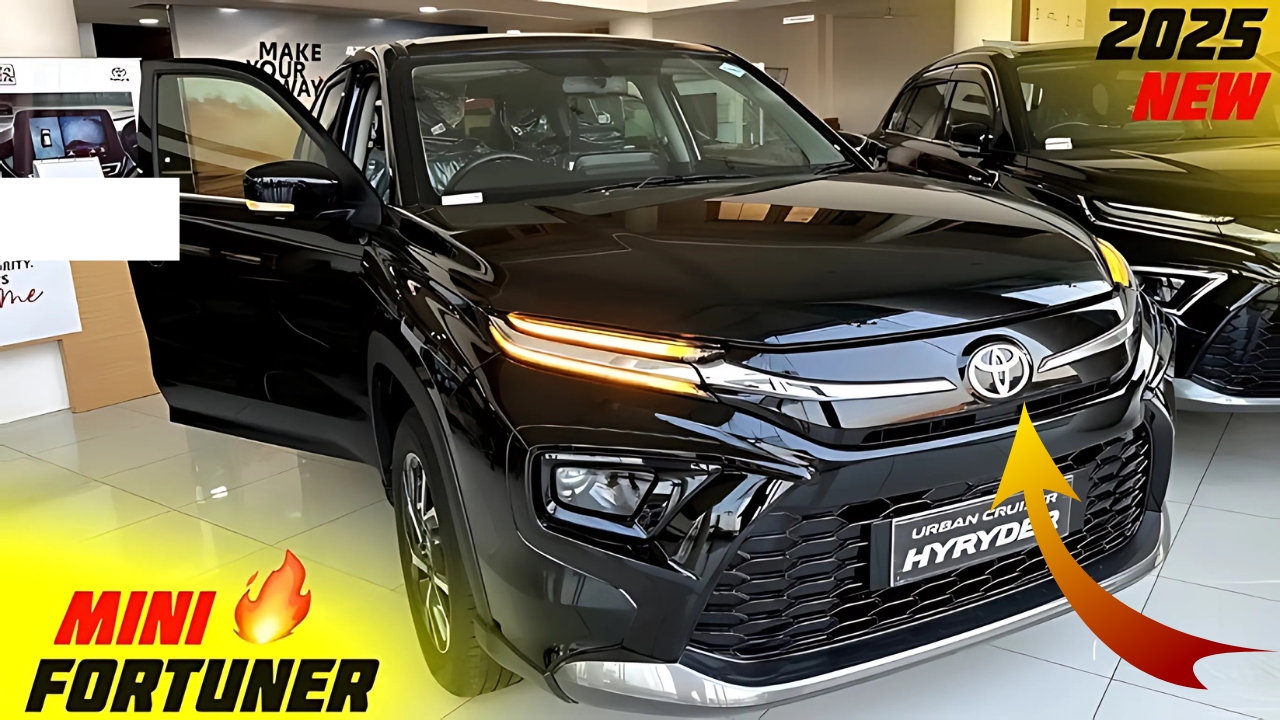Toyota Hyryder : The debut of the Urban Cruiser Hyryder by Toyota in mid-2022 caught the attention of the automotive world due to its apparent resemblance to its higher-priced counterpart, the Fortuner. This similarity is not only cosmetic; it represents a strategic decision aimed at positioning the Hyryder as a more accessible option in India’s tough SUV market, providing prospective buyers with a taste of Fortuner aesthetics at a fraction of the price.
The most noticeable links between the two models are found in the Hyryder’s frontal design. Featuring a prominent chrome-accented grille with horizontal slats resembling those found on higher-end Toyota models, the Hyryder captures a visual connection that is hard to overlook. The sharp, angular headlamps, complete with signature LED daytime running lights, enhance its aggressive outlook, something that gives it a presence comparable to the Fortuner on the road.
Vikram Desai, a Fortuner owner, recounts mistaking the Hyryder for a compact variant of the Fortuner, illustrating how effectively Toyota has adapted its premium design elements into this smaller vehicle. The pronounced wheel arches and gently rising beltline continue this design narrative, giving the Hyryder a family resemblance that aligns it closely with the Fortuner. Even the alloy wheels on higher trims echo styles found in certain Fortuner editions, adding an element of sophistication.
Toyota Hyryder Premium Interior Touches Within Reach
The design continuity is evident not just outside but also inside the vehicle. Toyota has incorporated several interior design elements that remind users of the Fortuner, though with materials that reflect the Hyryder’s comparatively lower price point. The dashboard’s layered design and the steering wheel’s control layout, although slightly smaller, showcase Toyota’s design philosophy where high-end touches are made accessible to a broader audience.
Sanjay Krishnan, who test-drove several competitors before purchasing a Hyryder, notes the familiarity of elements like the door handle design and center console layout he recognized from the Fortuner. Such features reflect Toyota’s effort to bridge the gap between luxurious design and affordability, making it a compelling choice for budget-conscious consumers. The higher-end variants also boast features such as ventilated front seats and a panoramic sunroof—luxuries previously reserved for much pricier vehicles.
Toyota Hyryder Sensible Engineering Beneath Familiar Styling
Underneath its design echoes of the Fortuner, the Hyryder is built with price-appropriate engineering decisions in mind. Instead of adopting the Fortuner’s robust ladder-frame construction, Toyota opted for a monocoque chassis, developed in collaboration with Maruti Suzuki. This decision not only helps keep the pricing competitive, starting at around ₹10.5 lakh, but also aligns with the Hyryder’s intended urban-lifestyle use.
Additionally, the Hyryder offers mild and strong hybrid variants, giving it certain advantages in fuel efficiency and technology over the Fortuner. Dr. Anand Kulkarni, an automotive technology consultant, praises Toyota’s strategic choices in borrowing the premium design aspects from the Fortuner while introducing more modern, efficiency-focused powertrains. This innovative approach positions the Hyryder favorably against its more expensive counterpart.
Toyota Hyryder Market Positioning That Leverages Legacy
With the Hyryder, Toyota has effectively leveraged brand equity by tapping into the visual appeal of the Fortuner to capture interest in the competitive compact SUV space. This strategy resonates well with Indian consumers who appreciate luxury design without the high price tag. As Priya Mehta reveals, the resemblance to the Fortuner played a significant role in her decision to purchase a hybrid variant of the Hyryder over competitors like the Hyundai Creta and Kia Seltos.
The visual impact of the Hyryder aligns closely with what many seek in a compact SUV. It allows buyers to experience Toyota’s premium aesthetic without the prohibitive costs associated with the Fortuner. By providing approximately 70% of the road presence at about 30% of the price, the Hyryder serves as an attractive option in the face of established competitors. As buyers look for greater overall value, the Hyryder’s Fortuner-influenced design emerges as a brilliant market strategy for Toyota, catering to evolving consumer preferences in today’s automotive landscape.
